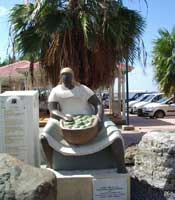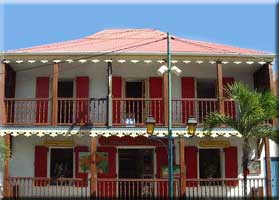
|
|
The term "Créole" means different things in different places, but it always refers to the blending of elements that result in something new. The Créole people of Louisiana are the descendants of French colonists in the New World, and Louisiana Créole cooking was born of the marriage of classical French technique and local ingredients never seen in La Belle France. Similar liaisons between the old and the new took place all over the Americas and the Caribbean, resulting in the vibrant cultures and cuisines we experience today. Luckily for visitors to St Martin, this island has been a particularly active crossroads for hundreds of years, and the culture and cuisine contain a bit of the best of everything. The semi-official explanation is that Créole cuisine was developed by the wealthy second born sons of European aristocracy who could not inherit land or titles in their native countries and came to the New World in the late 1600s, bringing their cuisine (and chefs) with them. Cajun is a contraction of Acadia, the area of Canada from which the French-Canadians were expelled when the British took over all of Canada in the mid-1700's.
|
|
About a third of them made it to New Orleans which was a still French colony, at least until Jefferson purchased it in 1803. Cajuns tended to make simple one pot meals (gumbo, for example) from what was readily available (fish and game) while the Créoles had more complicated multi-course meals using finer ingredients.
|
The Créole houses also tended to be finer, multi-story affairs with wrought-iron balconies. Today, no Mardi Gras coverage is complete without a clip of some revelers on these balconies flinging beads to the masses below. The Cajuns tended to live in fishing shacks, frequently on posts on the bayous.
The same house dichotomy exists in St Martin, especially on the French side. One of the finest examples of a Créole house (and most accessible to the public) is Roland Richardson's Gallery on Rue de la République in Marigot (above left). The Cajun shack found in New Orleans is called a Créole cottage here in the islands. Right around the corner from the Richardson Gallery is Jean-Claude's hair salon in one of the island's finer Créole cottages (right). The first most certainly started life as a large and fine home and today is a lovely gallery and studio space with an interior garden. Jean-Claude's establishment is considerably smaller with a bit of a garden in front and, though smaller, it is quite lovely, almost as colorful as Roland's paintings.
|
|
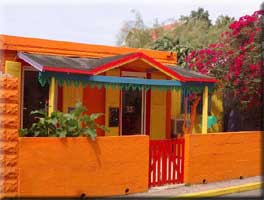
|
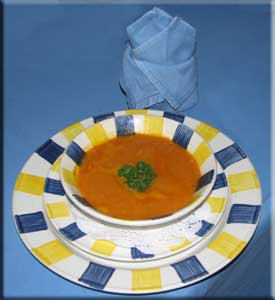
|
|
In the Caribbean, Créole frequently means indigenous, or anyone born here. Nonetheless, the Caribbean, like New Orleans, did receive its share of aristocracy bringing chefs and European traditions. Recently, established chefs have arrived bringing their traditions. The local native culture and freed black slaves produced a cuisine similar to the Cajuns in New Orleans. Combine these influences with new and different foodstuffs available only in the year-round warmth of the Caribbean and one can put together a most interesting dinner.
We'll start our dinner with conch chowder from Antoine Restaurant on Frontstreet in Philipsburg. The conch originally came from the warm local waters and chef/owner Pierre-Louis Kesner is a local. His partner, Jean-Pierre Pomarico runs the front of the house and brought us Pierre-Louis's colorful creation. The deep red comes from the tasty tomato base and the chewy conch provides an interesting textural sensation in this wonderful soup. The recipe is easy and all the ingredients are readily available - except the conch. We've snorkeled these waters for years and I've only seen a live conch once outside the confines of the Orient or Créole Rock marine parks. Frozen conch (generally from South or Central America) is usually available in the supermarkets, notably Sang's at the head of Philipsburg and US Imports next to the French bridge in Sandy Ground. Pair this soup with a rosé. The Domaine de Sainte Croix from the Côtes de Provence is a lighter rosé while the Château Miraval from the same region is a full-bodied version. Neither is very sweet and both can be found at Select Wine Cellar in Cole Bay.
|
|
Our appetizer will be accras from across the street at L'Escargot Restaurant, one of the islands oldest restaurants, still run by Joél and Sonya Moreau, and still featuring an outrageous cabaret act weekly in a brilliantly painted Créole cottage. The restaurant is decidedly French and does have several approaches to snails on the menu, but the chef turns out some very tasty accras, salt cod fritters. According to cookbook writer Jessica Harris, akkra were originally made in Benin in West Africa from white beans. After the gold rush in the 1500s, trading became important in the New World and the trading depended upon the circular winds heading south from Europe to Africa and then west as the trade winds toward the Caribbean. From there, the east coast of the US was reachable and as the ships headed north, the prevailing westerly winds pushed the ships across the north Atlantic back to Europe.
|
|

|
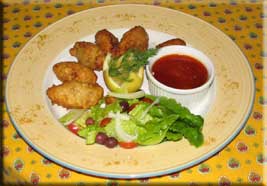
|
|
The same ships that brought slaves to the Caribbean and the southern US picked up salt and rum in the Caribbean and bales of cotton in the US south. These things were exchanged for salted codfish in New England and the Canadian Maritimes as the ships returned to England. They then took cotton cloth south to Africa and beyond. Eventually the akkra recipe reached the Caribbean along with some salt cod. The two merged and the island version of accras was developed. For this course, a light chardonnay would be nice. The Petit Chablis or even the Chablis made by Domain Gerard Trembley can be found at Select Wine Cellar.
Salt cod can also be found in supermarkets and if you want to make your accras from scratch, that is the way to start, although US Market at the bridge in Sandy Ground usually has frozen accras already made. Restaurants have a deep fryer, but we just fry our accras up in a large skillet. They do need a spicy dipping sauce and every supermarket has a large selection. Martha generally makes her own version of sauce chien. Fish always tastes better with a bit of lemon and a bit of crisp lettuce adds an additional temperature and texture to this dish.
|
|
For our main course, we head to Simpson Bay to visit Skipjack's Seafood Grill, Bar, and Fish Market. The restaurant is named after a two-sail sloop found on Maryland's Eastern Shore. The boat was named after the speedy, agile, and powerful Skipjack Tuna. Oysters can only be taken from sailing vessels in Maryland, so there are still Skipjacks plying Chesapeake Bay. Appropriately, Skipjack's menu features fresh fish and there is even a fish market at the entrance. We always check to see what looks best as we enter. One evening the grouper looked especially good and after it was offered with crab meat stuffing, we were hooked, so to speak.
|

|
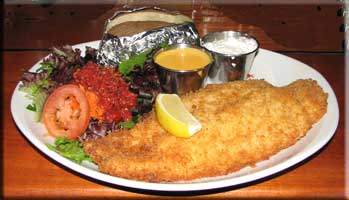
|
Grouper is frequently available at Skipjack's fish market and possibly at the nearby Simpson Bay fish market. We've seen it in the larger supermarkets at times. Other firm-fleshed, white fish can easily be substituted as the crab and spices in the stuffing are the main flavor elements. A crisp and sturdy chardonnay or a light red wine would pair nicely with this dish. The Saint Romain (chardonnay) from Pierre Morey and the Borgogne Pinot Noir from Guy Amiot can be found at Select Wine Cellar.
|
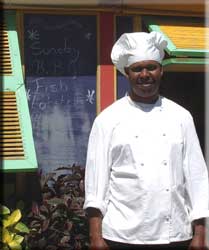
|
For dessert we visited Carl Phillips at Ti Coin Créole in Grand Case. Currently, this Créole cottage, a few short steps from the beach, is his restaurant, but it was the house where he grew up. The menu is simple, but offers a large number of variations on Créole recipes featuring chicken, shrimp, lamb, goat, conch, and fish.
|
|
Carl created a dense sweet potato pudding, more like a brownie. It's hard to believe that a simple potato could taste so good, but this is the beauty of this branch of Créole cooking. Take something abundant and inexpensive (i.e, a sweet potato in a temperate climate) and add readily available spices (cloves, pepper, vanilla), and a few other readily available foodstuffs (bananas and coconuts), and you can produce something that rivals the finest desserts in the world. Try a sturdy Bordeaux to go with this dessert, perhaps a Château Puyanché Château Haut Bellevue.
|
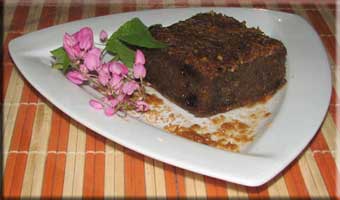
|
There you have it, another fine island meal. You can visit these restaurants and sample the chefs' creations or make your own at home. Don't forget the wine.
Try the recipes below and Bon Appetit!
|

